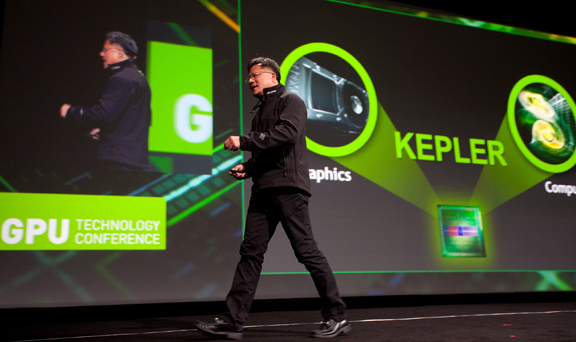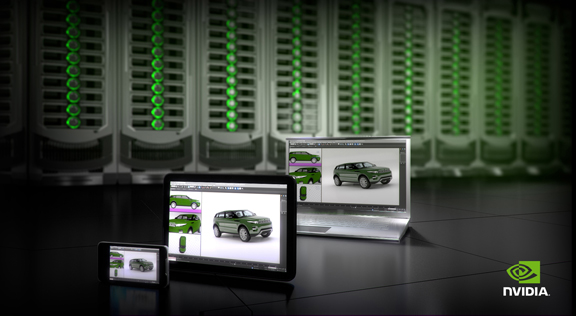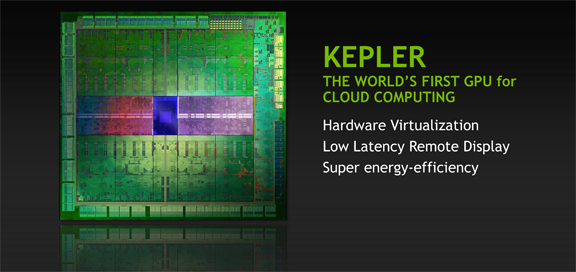Latest News
May 16, 2012
Soon, you could be rendering images, animating 3D scenes, and playing games on a GPU without a GPU.
To prove this point, NVIDIA CEO Jen-Hsun Huang took the stage on Tuesday May 15, 2012, at the San Jose Convention Center, the site of this year’s GPU Technology Conference (GTC 2012).
“I want to announce a GPU that we can all simultaneously share. Today, we’re going to take the GPU into the cloud,” Huang said. “This is an endeavor we’ve been working on for five years ... For the first time, we’ve virtualized the GPU. No longer does the GPU have to be connected to a device.”
The GPU virtualization is made possible by Kepler, NVIDIA’s next generation GPU architecture. “Kepler can render and stream instantaneously right out of the chip to a remote location you choose,” according to Huang. “One GPU can now be shared with countless users.”
With virtualization, you can, for instance, access a GPU-driven digital-content creation or design software hosted on a remote machine from a lightweight tablet device that serves as a client. To demonstrate this, Huang invited Grady Cofer, the visual effects guru from Industrial Light and Magic, to remotely access and edit scenes from Battleship (Universal, 2012) in real-time, using an iPad.
The demonstration was followed by another on cloud gaming, as Dave Perry, a 25-year veteran of game development and CEO of Gaikai, joined Huang to play HAWKEN, a multi-player 3D game, streaming on an Asus Transformer Prime tablet and a TV simultaneously.
Haung called Kepler “a big, big deal for us .. It’s the best GPU we’ve ever built, the most energy-efficient GPU we’ve ever built, and the most feature-packed GPU we’ve ever built.” Kepler’s energy-efficient design, Huang expected, would make the GPU an attractive processor to drive data centers.
Kepler’s energy efficiency comes from a combination of increased processing cores and reduced control logic, NVIDIA explained. The other two characteristics of Kepler are: Dynamic Parallelism, the ability to dynamically spawn new threads on its own without going back to the CPU; and Hyper-Q, the ability to communicate with multiple CPU cores simultaneously.
For desktop gaming and entertainment, GeForce GTX 680 is the product that runs on Kepler architecture. For high-performance computing (HPC), Tesla K10 and K20 are the products powered by Kepler.
“A single Tesla K10 accelerator board features two GK104 Kepler GPUs that deliver an aggregate performance of 4.58 teraflops of peak single-precision floating point and 320 GB per second memory bandwidth ... [K20] delivers three times more double precision compared to Fermi architecture-based Tesla products and it supports the Hyper-Q and dynamic parallelism capabilities,” according to NVIDIA.
GeForce GTX 680 and Tesla K10 is now available on the market; Tesla K20 is set to debut in fourth quarter of 2012.
Hardware virtualization has become standard practice in enterprise IT architecture, because of the opportunity to share computer resources among several users. The ability to house a single data set on a single machine or data center, remotely accessible from employees’ preferred devices (running on different CPUs, GPUs, and OSs), also offer other benefits, such as IP security and convenience. With virtual GPUs, NVIDIA’s pursuit of the HPC market intensifies.
Cisco’s David Yen, who joined Huang on stage during GTC’s opening day keynote, said, “Cloud computing is changing the old client-server model. Servers, data centers, and the Cloud become synonymous.
Subscribe to our FREE magazine, FREE email newsletters or both!
Latest News
About the Author
Kenneth Wong is Digital Engineering’s resident blogger and senior editor. Email him at [email protected] or share your thoughts on this article at digitaleng.news/facebook.
Follow DE








